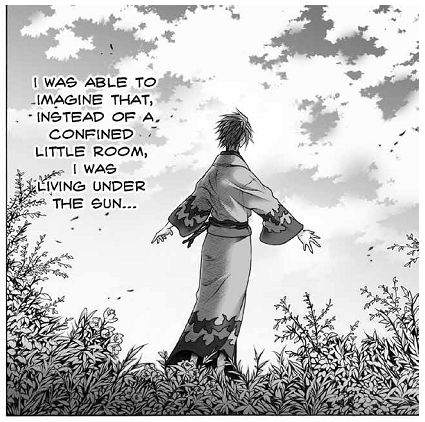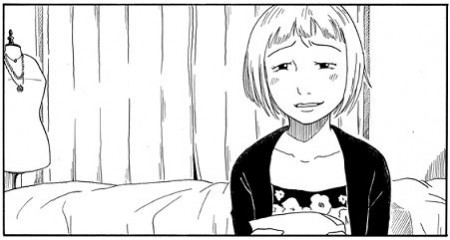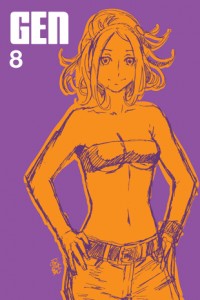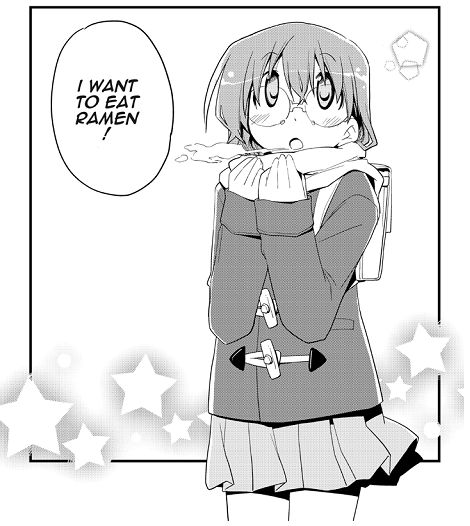Gen Issue 8 Review
I’m inexcusably a bit behind on reading and reviewing the monthly manga anthology GEN, so I’m going to try to briskly catch up beginning with issue 8.
Gen issue 8 immediately impresses readers with its striking, attractive cover drawn by veteran Japanese illustrator Junji Ohno. After its immediate and simple but effective first impression, the issue launches into a brisk start.
The anthology once again begins with Nakamura Shige’s engaging, retro-inspired boxing drama “Wolf.” As if the narrative itself is trying to evoke the spirit of the boxing it depicts, the eighth chapter throws the reader a left hook narrative punch then follows up immediately with another conflict from an entirely different angle, quickly followed by a third unexpected gut punch narrative twist. From the outset, “Wolf” has been on of Gen’s stronger entries, and the dramatic turns in this chapter effortlessly elevate the story to another, higher level of tension and emotion.
This issue’s installment of Mihara Gunya’s “Kamen” is the longest chapter so far, setting up immediate but significant story development. Although this chapter still refuses to answer many questions, it’s a more satisfying chapter than many previous ones just because of its greater length and substance.
While background art and screen tone remain as fine in Karino Arisa’s “Souls” as they’ve always been, the character art – proportion in particular – continues to improve. Character faces now look normal and naturally expressive, yet numerous characters’ necks still seem distractingly unnaturally long. The revelation contained within this chapter and the following story and character development finally provide vital context for the story. While the situation may now be clearer, the story may still have been better served by providing this important explanation a few chapters earlier in the narrative.

Standing in for this month’s installment of Sorako, creator Fujimura Takayuki instead provides the short, self-contained story “Intercolor,” a very concise, uncomfortably funny relationship drama that may require a moment of consideration before its meaning becomes apparant. The visual art in this chamber piece is entirely adequate, with facial expressions especially conveying a strong sense of tentative uncertainty and barely suppressed guilt. This chapter is also the first of Gen issue 8 to literally translate Japanese text instead of leaving text in Japanese and adding footnote translations. The abruptness of the English text translation is a sudden, jarring change after the three earlier stories in the anthology, a bit of an editing weakness unrelated to the actual manga story itself.
Whether by design or coincidence, I don’t know, but this issue’s chapter of Hajime Taguchi’s “Alive,” a self-contained tragedy about a caged bird that finds its own wings all too briefly, is a stylistic parallel to the “Intercolor” story that preceeds it, although this “Alive” story is far less subtle in its parable. Coming across as a particularly adult-oriented manga story, this short tale revolves around domestic violence and includes brief nudity and mildly graphic sex. This chapter also continues to translate Japanese signs and, for the first time in the issue, includes just two isolated instances of translated sound effects.

The third chapter of Ryo Hanada’s “Good-bye Geist” continues with its especially narrow focus that gives particular scenes a great sense of immediacy and believability but makes seeing the larger plot very difficult. The effect is a manga chapter that’s intriguing but frustrating. While it would be a bit unsatisfying on its own, when complimented by the other manga in the anthology, “Good-bye Geist” contributes to the anthology’s dynamic contrast of manga styles and tones.
Gen issue 8 closes with the debut of Nagumo’s original manga “Let’s Eat Ramen,” the anthology’s first inclusion from a veteran, professional manga-ka. Although not especially well known in America, Nagumo is the creator of manga series including Radio de Go! and Water Girls, both published in Manga Time Kirara Carat magazine. The two chapters of “Let’s Eat Ramen” are a lighthearted budding romance story revolving around a high school girl fascinated by ramen but nervous about visiting the ramen restaurants typically patronized by middle-aged businessmen. The cute and fun story is enhanced by Nagumo’s light, almost anime-esque art that’s particularly reminiscent of fellow Manga Time Kirara Carat artist Kiyuzuki Satoko (GA ~ Geijutsuka Art Design Class). Ending Gen issue 8 and coming full circle back to its beginning, this chapter, like the issue’s first three manga, keeps Japanese signs and text (mostly) in Japanese with sidebar translations and leaves visual sound effects unaltered and untranslated, in at least one case, to great effect.
Gen has been an outstanding English language primer for cutting-edge Japanese independent manga, but issue 8 elevates the magazine to a new height with its inclusion of a gorgeous cover and a new original manga from established, professionally published Japanese manga-ka. The contrast allows astute readers to really examine the subtle differences between manga by aspiring independent Japanese creators and those who have successfully launched careers in the manga industry. The contrast also brings readers an even more diverse spectrum of contemporary manga variety, including sport, fantasy adventure, historical drama, seinen drama, and romantic comedy. The quality and integrity of the Gen anthology has been steadily increasing with each issue, from the ambitious but uneven first issue to solid, confident issues like this one that have a distinctly tangible purpose and include strong, pointed manga that no longer look and feel tentative. Manga enthusiasts should not only be subscribing to and supporting Gen to encourage its principle but also to appreciate the diversity and quality of the unique manga it’s now bringing to English speaking readers.
The PDF versions of the issue available to subscribers is bright and crisp, available in both single page and double-page spreads. The print edition may be thinner than typical domestically published manga at the same price, but the quality of the content and the exceptional tactile quality of the heavy stock covers and bright white page stock absolutely justifies the price for collectors that prefer a physical copy.





